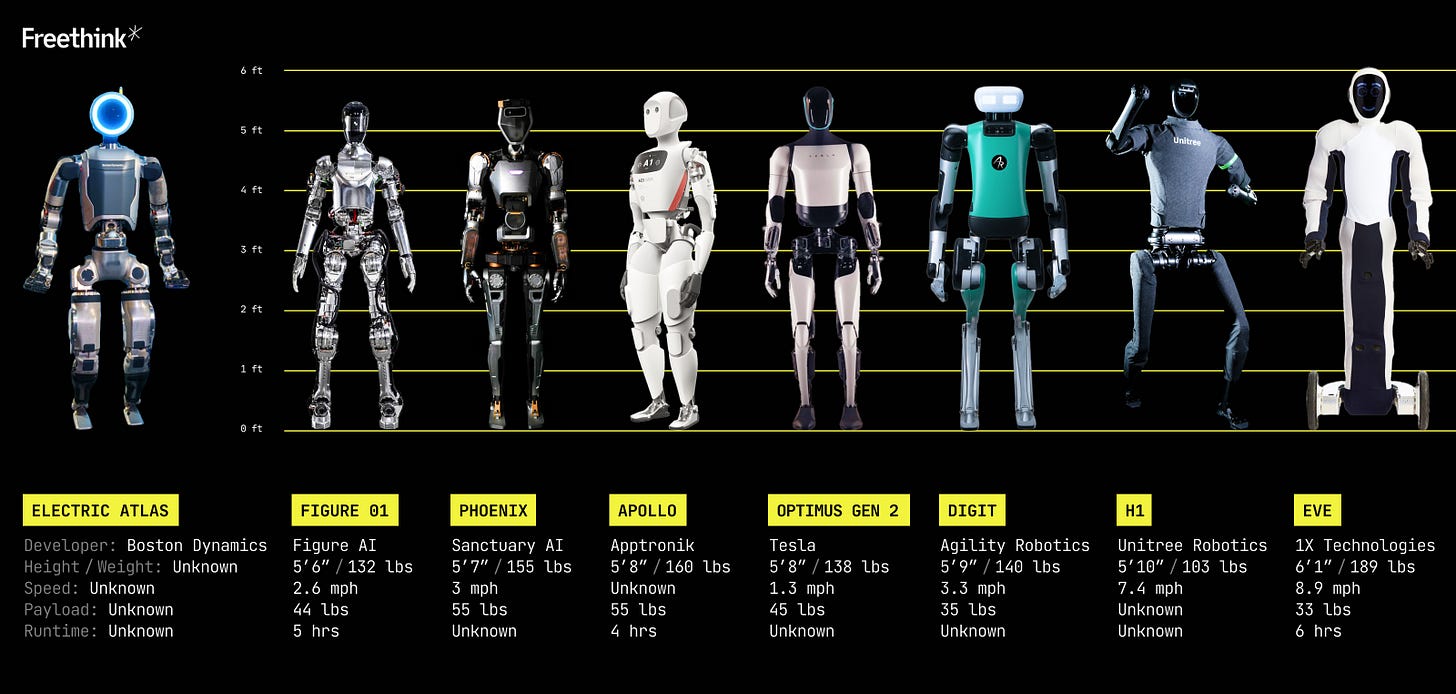Humanoid Robots Are Coming — But Are We Ready?
Exploring what it means to share our workspaces with machines that walk, talk, and think like us.
When OpenAI CEO Sam Altman was asked where AI was headed next, his answer was simple and startling: "humanoid robots." Not as a distant fantasy, but as an imminent reality. Advances in AI and robotics are converging to bring life-like robots from sci-fi into our homes, hospitals, warehouses, and streets.
If you're imagining a world where humanoid robots deliver your groceries, assist in elderly care, or assemble your next car — you’re not alone. But as thrilling as this future may sound, it also raises important questions: What will these robots do to the job market? How will we relate to them socially? And perhaps most importantly - are we truly ready?
Meet the Humanoids
They walk, gesture, and even make eye contact. From factories to eldercare homes, these robots are no longer prototypes — they're colleagues.
🤖 From Sci-Fi to Reality: The Rise of Humanoid Robots
Humanoid robots — machines designed to resemble and interact like humans - have long captured our imagination. Think C-3PO, Ex Machina, or I, Robot. But today’s developments are moving beyond Hollywood.
Startups like Figure AI and Agility Robotics are building robots that can walk, carry boxes, hold conversations, and even navigate complex environments. Earlier this year, Figure unveiled a humanoid robot powered by OpenAI's language model that could have basic conversations, recognize objects, and perform tasks.
Meanwhile, Tesla's Optimus robot continues to evolve — Elon Musk claims it will “transform the economy” by replacing human labor in repetitive and dangerous tasks. Whether or not you buy into that vision, it’s clear that humanoid robots are no longer theoretical. They’re being funded, tested, and deployed.
🧠 Workforce Implications: Jobs at Risk or New Opportunities?
With humanoid robots on the rise, headlines warning of massive job losses have resurfaced. But as I explored in last week’s issue, the truth is more nuanced.
Instead of replacing humans outright, many of these robots will augment existing roles — assisting workers in warehouses, helping nurses in hospitals, or enabling new job categories like robot supervisors or human-AI interaction designers. Just like self-driving trucks created the role of autonomous fleet managers, humanoid robots may generate an ecosystem of hybrid jobs that combine physical tasks with digital oversight.
But we must remain vigilant. Lower-wage, routine jobs — particularly in logistics, manufacturing, and even hospitality — are at greater risk of disruption. Policymakers and companies will need to prioritize reskilling, equity, and access to ensure the transition is inclusive.
⚖️ Ethical Considerations: Rights, Responsibilities, and Boundaries
As robots become more humanlike in appearance and behavior, ethical concerns multiply.
Should humanoid robots have rights?
Is it ethical to create machines that mimic emotions?
Can we trust them with sensitive care tasks, like looking after children or the elderly?
There’s also the data question. Robots equipped with cameras, microphones, and sensors raise significant privacy risks. Who owns the data they collect? How do we protect users — especially vulnerable ones?
And then there’s bias. AI systems inherit biases from their training data. If a humanoid robot is trained on flawed or biased datasets, its decisions — and behaviors — can mirror those inequalities in the real world.
These are not hypothetical problems. They require urgent dialogue and clear frameworks — and right now, regulation is lagging far behind innovation.
🌍 Societal Readiness: Are We Prepared?
According to a 2023 Pew Research Center survey, only 30% of Americans felt comfortable with the idea of robots providing care for the elderly. Meanwhile, many workers report anxiety about automation, fearing that they’ll be left behind in a skills race.
Beyond emotional readiness, there's also a design question. Will robots be intuitive enough for the average person to interact with safely and comfortably? Will they reflect the diversity of the societies they’re entering — or reinforce stereotypes?
Education, public awareness, and inclusive design will be crucial in ensuring society is ready for humanoid integration.
🧪 Research Highlight: Automation from the Worker’s Perspective
A recent arXiv study titled “Automation from the Worker’s Perspective” offers a fresh lens. It reveals that many workers don’t fear automation per se — they fear poor implementation.
Workers expressed a desire to have a say in how new technologies are introduced, emphasizing the importance of transparency, fairness, and respect. This suggests that with the right approach, AI-powered robots can be a partner, not a threat.
🛠️ Tool of the Week: Figure AI
Figure AI is building general-purpose humanoid robots with advanced AI systems. Their goal? To deploy robots that can safely and efficiently work alongside humans — doing everything from warehouse tasks to customer service.
Keep an eye on this company — it’s one of the best indicators of where humanoid robotics is headed.
🧭 Final Thought: Beyond the Hype
It’s easy to get swept up in the extremes — either utopian visions of robotic coworkers or dystopian fears of mass job loss. But the reality is messier, and more exciting.
Humanoid robots will likely enter our world gradually, not all at once. Their success will depend not just on the sophistication of their engineering, but on our willingness to adapt, regulate, and design inclusively.
Thanks for reading — and as always, stay curious, stay critical.
— Emine 🧠✨



